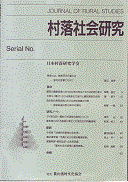Volume 3, Issue 2
Displaying 1-11 of 11 articles from this issue
- |<
- <
- 1
- >
- >|
-
1997Volume 3Issue 2 Pages 1-7
Published: 1997
Released on J-STAGE: March 29, 2013
Download PDF (6033K) -
1997Volume 3Issue 2 Pages 8-21
Published: 1997
Released on J-STAGE: March 29, 2013
Download PDF (12703K)
-
1997Volume 3Issue 2 Pages 22-34
Published: 1997
Released on J-STAGE: March 29, 2013
Download PDF (10146K)
-
1997Volume 3Issue 2 Pages 35-41
Published: 1997
Released on J-STAGE: March 29, 2013
Download PDF (6027K)
-
1997Volume 3Issue 2 Pages 42-47
Published: 1997
Released on J-STAGE: March 29, 2013
Download PDF (5037K)
-
1997Volume 3Issue 2 Pages 48-49
Published: 1997
Released on J-STAGE: March 29, 2013
Download PDF (1875K) -
1997Volume 3Issue 2 Pages 50-51
Published: 1997
Released on J-STAGE: March 29, 2013
Download PDF (1822K) -
An Analysis of the Relation Between the Administrative Village and Rural Communities by Kunio Ohkama1997Volume 3Issue 2 Pages 52-53
Published: 1997
Released on J-STAGE: March 29, 2013
Download PDF (1873K) -
2009Volume 3Issue 2 Pages 54-55
Published: 2009
Released on J-STAGE: March 29, 2013
Download PDF (1920K) -
1997Volume 3Issue 2 Pages 56-57
Published: 1997
Released on J-STAGE: March 29, 2013
Download PDF (1839K) -
1997Volume 3Issue 2 Pages 58-59
Published: 1997
Released on J-STAGE: March 29, 2013
Download PDF (1781K)
- |<
- <
- 1
- >
- >|
